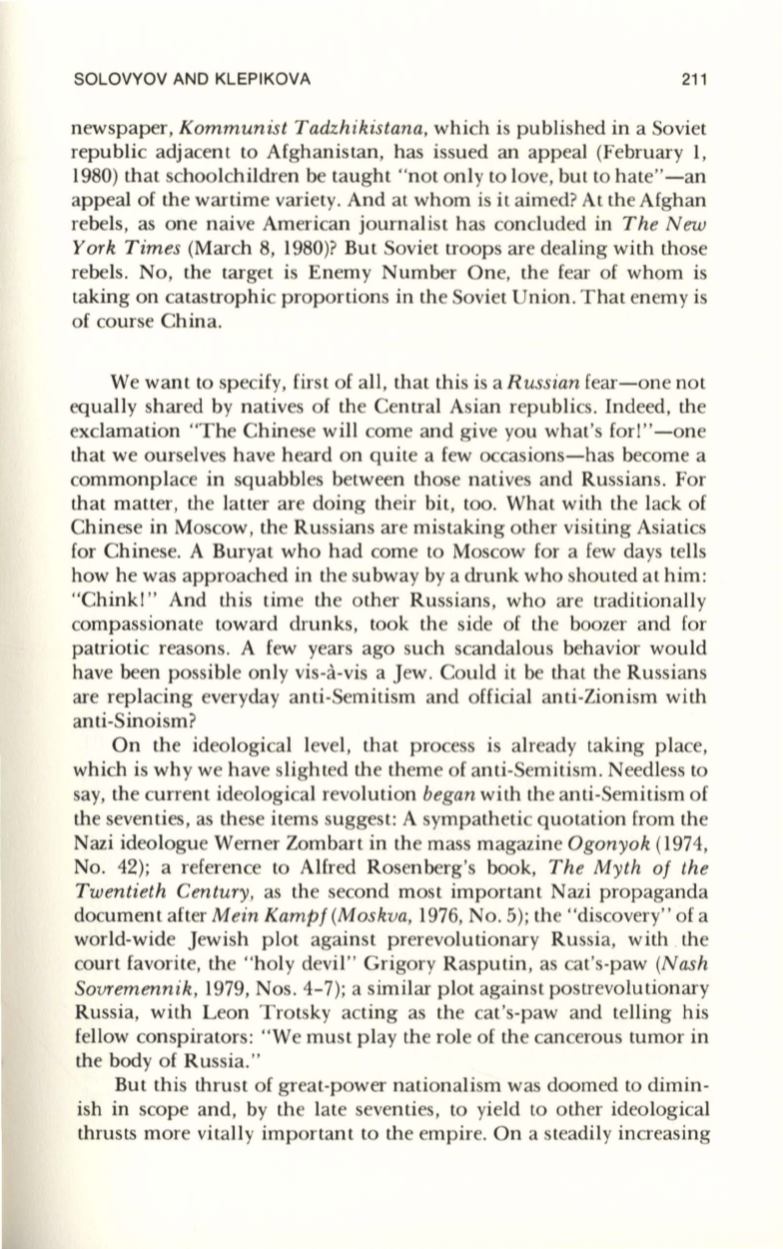
SOLOVYOV AND KLEPIKOVA
211
newspaper,
Kommunist Tadzhikistana,
which is published in a Soviet
republic adjacent to Afghanistan, has issued an appeal (February I,
1980) that schoolchildren be taught "not only
to
love, but to hate"-an
appeal of the wartime variety. And at whom is it aimed? At the Afghan
rebels, as one naive American journalist has concluded in
The New
York Times
(March 8, 1980)? But Soviet troops are dealing with those
rebels. No, the target is Enemy Number One, the fear of whom is
taking on catastrophic proportions in the Soviet Union . That enemy is
of course China.
We want to specify, first of all, that this is a
Russian
fear-one not
equally shared by natives of the Central Asian republics. Indeed, the
exclamation "The Chinese will come and give you what's for!"-one
that we ourselves have heard on quite a few occasions-has become a
commonplace in squabbles between those natives and Russians. For
that matter, the latter are doing their bit, too. What with the lack of
Chinese in Moscow, the Russians are mistaking other visiting Asiatics
for Chinese. A Buryat who had come to Moscow for a few days tells
how he was approached in the subway by a drunk who shouted at him:
"Chink!" And this time the other Russians, who are traditionally
compassionate toward drunks, took the side of the boozer and for
patriotic reasons. A few years ago such scandalous behavior would
have been possible only vis-a-vis a Jew. Could it be that the Russians
are replacing everyday anti-Semitism and official anti-Zionism with
anti-Sinoism?
On the ideological level, that process is already taking place,
which is why we have slighted the theme of anti-Semitism. Needless to
say, the current ideological revolution
began
with the anti-Semitism of
the seventies, as these items suggest: A sympathetic quotation from the
Nazi ideologue Werner Zombart in the mass magazine
Ogonyok (1974,
No. 42); a reference to Alfred Rosenberg's book,
The Myth of the
Twentieth Century,
as the second most important Nazi propaganda
document after
Mein Kampf (Moskva,
1976, No.5); the "discovery" of a
world-wide Jewish plot against prerevolutionary Russia, with . the
court favorite, the "holy devil" Grigory Rasputin, as cat's-paw
(Nash
Sovremennik,
1979, Nos. 4-7); a similar plot against postrevolutionary
Russia, with Leon Trotsky acting as the cat's-paw and telling his
fellow conspirators: "We must play the role of the cancerous tumor in
the body of Russia."
But this thrust of great-power nationalism was doomed to dimin–
ish in scope and, by the late seventies, to yield to other ideological
thrusts more vitally important
to
the empire. On a steadily increasing


